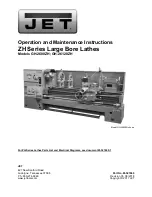
– 31 –
6.
NORME DI FUNZIONAMENTO • OPERATING PROCEDURES
ENGLISH
ITALIANO
6.3.
USO DEI PRINCIPALI
ACCESSORI
In questo paragrafo descriviamo
le metodologie corrette per un uso
appropriato dei principali acces-
sori:
– Contropunta
– Lunetta fissa
– Dispositivo a copiare
– Lunetta mobile
6.3.1 Contropunta (fig.4)
Nelle lavorazioni con la
contropunta il pezzo da lavorare
deve essere bloccato fra il canot-
to F e il trascinatore seguendo le
istruzioni sotto riportate:
- Sbloccare la leva C e posizio-
nare la contropunta a contatto
del pezzo da lavorare.
- serrare la leva C.
- sbloccare la leva E e agire sul
volantino D inserendo il canotto
F nel centro del pezzo da lavo-
rare.
- serrare la leva E.
6.3.2 Lunetta fissa (fig.5)
La tornitura di pezzi lunghi rispetto
al loro diametro è particolarmente
difficoltosa a causa delle vibrazio-
ni che il pezzo può subire durante
il lavoro. Queste vibrazioni non di-
pendono assolutamente dal catti-
vo funzionamento del tornio ma
dalla elasticità del legno in lavoro.
Per poterle eliminare occorre mon-
tare la “lunetta” H che ha la funzio-
ne di creare un terzo punto di
appoggio al pezzo in lavoro fra la
punta e la contropunta del tornio.
Il bloccaggio della lunetta nella po-
sizione voluta si ottiene agendo sul-
la leva B come indicato in fig. 5.
Per escludere la lunetta è sufficien-
te accostarla alla testata della mac-
china, oppure separarla dal
supporto A che può essere lascia-
to accostato alla testata senza cre-
are disturbo.
Quindi, una volta montato, non è
più necessario smontare il suppor-
to anche se non si usa la lunetta.
Per lavori di particolare difficoltà o
lunghezza è necessario montare
anche due lunette.
6.3.
OPERATION OF THE
MAIN ACCESSORIES
This paragraph will describe how
to operate the main accessories
in the correct way:
– Tailstock
– Fixed steady
– Copying device
– Mobile steady
6.3.1 Tailstock (Fig.4)
When machining with the tailstock,
the piece to be machined must be
locked between the shell F and
the driver, following the instructions
below:
- Release the lever C and position
the tailstock in contact with the
piece to be machined.
- Tighten the lever C.
- Release the lever E and operate
the handwheel D inserting the
shell F in the centre of the piece
to be machined.
- Tighten the lever E.
6.3.2 Fixed steady (fig.5)
Turning workpieces which are long
in comparison with their diameter
is rather difficult due to the vibra-
tions which the piece is subjected
to during machining. These vibra-
tions are not caused by lathe mal-
functioning but by the resiliance
of the wood during machining.
To eliminate vibrations install the
fixed steady H ; it creates a third
point of support for the workpiece
between the center and the
tailstock of the lathe.
To block the steady in the desired
position lever on B as shown in fig. 5.
If the steady does not need to be
used, rest it against the headstock
or remove it from the mount A
which can be brought against the
headstock without interfering with
machine operations.
Once the mount has been installed,
it does not have to be removed
even if the steady is not used.
When difficult jobs are to be per-
formed or long pieces are to be
handled, two steadies should be
mounted.
08_045_0.tif
Fig. 4
D
E
F
C
08_046_0.tif
Fig. 5
H
B
A






































